Application of Enhanced CPC for Load Identification, Preventive Maintenance and Grid Interpretation
Abstract
1. Introduction
2. Materials and Methods
2.1. Introducing CPC Theory—An Introduction Directed to Anomaly Detection and Grid Interpreting
2.2. Introducing “A Preprocessor Cascaded to Anomaly Detection Core” Design
2.3. Development of CPC Time-Domain and Spectral-Domain Model Sensing
2.4. Enhancement of CPC in Favor of Grid Deciphering Mechanism—Formulation of E-CPC Theorems
2.5. Generation of Additional Scatter and Reactive Currents by Recursive Operation of CPC
2.6. Reuse of Existing CPC Functions
2.7. Benefits of Enhanced CPC as a Grid/Machinery Deciphering Method
2.8. Enhancement to Three-Phase Three-Four Wire and Inclusion of Unbalanced Load
2.9. Quantitative Comparative Evaluation of the E-CPC Model Anomaly Detection Property Using a CNN Deep Learning Core—Enablement of Multi-Channel “Anomaly Detection”
Presentation of the Concept
2.10. “CNN for the E-CPC Anomaly Detection” Scheme—A Multi-Channel Anomaly Space
3. Results
3.1. Experimental Layout
3.2. Case Study 1: Diagnose Mechanical Safety Phenomena: Loose Screws of Motor Mounts through Grid Measurement
3.3. Case Study 2: Enhanced CPC—By Further Disassembling the Currents
3.4. Case Study 3: Diagnosing a Mild Change in Electric Load Over a Rectifier—Grid Measurement
3.5. Case Study 4: A Systematic Approach of Generating Features for AI Anomaly Detection
3.6. Case Study 5: Results of the Comparative Study of E-CPC vs. FFT Over Raw Time-Series Data and Theoretical Discussion
3.7. Comparison of the Proposed CNN Architecture to Other Studies
- (a)
- Similar work on electric grids: when discussing previous comparative work, the more accurate location to look for is not grid anomaly detection in general; that yields tens of references. Samples of non-electric anomaly detection are [51,52], none of grid anomaly detectors, is multichannel. Example 1D CNN works are [53,54,55] and LSTM works are [56] and CNN LSTM work [7]. A literature survey was performed starting in 2010. The conclusion is as follows: similar work has been performed on multichannel anomaly detection but probably not with regard to implementation for electric grids. Only or mostly a single-channel work has been performed over an electric grid.
- (b)
- For usage of electricity theory knowledge for data preparation (preprocessor), no other work has been found, so this may be the first one, or at least the first one with extensive electricity knowledge.
- (c)
- Accuracy: is the highest reported accuracy among all reported detectors, but some comparative work over anomaly detection datasets must be performed to make a solid conclusion. Currently this is not sufficiently established. There have been reports of 92% accuracy. The average reported accuracy is ~70%.
- (d)
- Grid references are based on the energy load profile as input, which has a low sampling rate of 0.001 Hz (every 15 min). This work is based on current and voltage recordings, which are rapidly sampled at 4 k Hz and may work well with 1 kHz. There are many voltage and current waveform recording probes in the grid at many deployments worldwide; therefore, this work does not require IoT installation in such projects. These probes are used for (1) fault location (2) and power quality monitoring.
4. Future Research
- (a)
- “Fan-in of IoT signals”. Due to the vacancy of 40,000 times less raw data, this may imply that fan-in with the same computational complexity can increase to up to 40,000 times larger than the raw data fan-in, which remains to be determined. However, it is shown that a preprocessing virtual sensor located at the data center, i.e., remote, much less raw data consumption, and more accurate, potentially leads to larger fan-in. The collaborative features make this sensor leap at anomaly detection.
- (b)
- “E-CPC + grid interpreting”—pushing the sensitivity limit further with electric-scheme- based anomaly detection. The E-CPC preprocessor, although executing a leap at anomaly detection, is not brought to its maximal performance. This may be achieved using grid deciphering theorems, especially 10-a, and Figure 8, if each of the electric components is inserted as a distinct anomaly detection signal. This has not yet been performed and is a future work of the group.
- (c)
- E-CPC as a generic preprocessor and virtual sensor. Not confined to the boundary of electric currents and voltages. This extension horizon is two-fold: there are five content worlds with equivalent physics to electric circuits, meaning there are pairs of signals equivalent to {voltage, current}: (1) magnetic, (2) heat transfer, (3) direct motion, (4) rotation motion, and (5) fluid dynamics. These contents worldwide are completely equivalent to electric circuits, so the results of this paper should be valid there. However, any signal may be split into active: and reactive: . Assuming some mean-field value extraction may be computed, fluctuations may be computed. The entire extent of E-CPC may be computed. There are fixed and scattered signal subcomponents. The current rule is matter conservation, a rule existing in many/most world contents. The power rule:is energy conservation. It exists in all world contents, so E-CPC must be a generic preprocessor suitable for any signal.
5. Conclusions
- Enlargement of “CPC physical components” components count, where each component serves as another type of grid sensor, all this without installing additional sensors:
- “Scatter and reactive currents” are natural anomaly detectors. They act nearly as 0/1 logic output. They were not invented by proposed work, but rather applied to the stated objectives.
- The “scattered currents” are insensitive to White-Gaussian-Noise (WGN) since that interference is spectrally constant, meaning fixed.
- Active/reactive fixed currents do notice WGN since they contain the spectrally fixed component. WGN may/or may not be an anomaly.
- “Customer current” is detecting current/harmonics arriving from load. Again – not invented, simply looked again at new perspective of grid change detection.
- Distribution current is detecting flow arriving from grid to load.
- Unbalance current is a natural detector of load unbalance.
- 2.
- Anomaly detection by CPC shown to be three folded- thereby enhancing its effect:
- Anomaly detection via the current’s physical components.
- CPC as good grid interpreting method, enables potentially anomaly detection at electric scheme level and components. This was demonstrated by two theoretical example experiments: (a) an array of parallel branches of serial load. (b) separability theorem demonstrating how CPC enables through harmonic analysis to separate inductive load from capacitive load.
- CPC in collaboration with CNN anomaly detector. The collaboration is stronger than each sub-component. The paper is focused on CPC, and CNN was used to enable comparative research over the input data. It is clear now that ‘CPC + CNN’ has a virtue of its own and should be further investigated.
- 3.
- Suitability to handle three phase three or four wire circuits was demonstrated: it was not invented. The enhancement was shown theoretically. Suitability to handle non-linear Harmonic Generating Loads (HGL): either as customer current that is not disassembled such as CPC acts, or at E-CPC at customer current’s proposed disassembly.
- 4.
- A new point of view has been shed on CPC, that’s different than original view but is mathematically, 100% equivalent. New point of view is effective for usage in the new disciplines and due to universality to other content worlds. That was not issue of current paper, simply a notification to generate incentive for a future paper: (i) “scatter current” is a spectral fluctuation over spectral mean field—This is a technique known from physical theories. (ii) “Active/reactive fixed currents” are the “spectral mean field”. (iii) “Active current” may be regarded as real component of spectral represented current, Reactive may be regarded as the imaginary component – thereby this is paving the way towards CPC as universal anomaly detector and universal data/fluid flow grid interpreter. That is beyond paper scope. Paper has triggered the curiosity.
- 5.
- Electricity theory knowledge was poured into deep learning architecture via preprocessing and data preparations: the cascade “CPC + CNN” was performed. There is usage of electric parameters by other works on grid analytics, but mainly as “statistical parameters”.
- 6.
- Improved data quality: comparatively over four simulations—the study showed that this enhances detection accuracy as compared to raw data, and FFT. (CPC is enhancement on FFT).
- 7.
- Speed-up the anomaly decision making and smaller amount of data—these points require further study, but the potential was shown. Due to FFT—only the 40 primary harmonics represent the loads well, and further compression due to CPC is obtained. At raw data 4kHz sampled ~800 time-series points exist for the same data.
- 8.
- Multi-channel IoT anomaly detection –multi-variate separate channels, as the CNN has been shown to be successful MV-CNN in other disciplines—that is not paper’s contribution. But usage cascaded with CPC, is the paper’s contribution, and multi-channel usage for grid although not novel, is shown herein differently. Potentially “multi-channel collaborative”—generate an aggregative anomaly detection through proper usage of convolution operation is implied by paper, although not demonstrated.
- 9.
- Grid interpreting. This is shown by two examples: (4.1) in Figure 7 as enabling “N parallel branches of serial R, L, C interpretation, where N is unknown”, (4.2) and at “separation of L, and C extraction” using CPC as theorem shows. Without CPC reactive admittance is sum of inductive and capacitive impedances (serial case)/admittances (parallel case). Relevancy to “grid interpreting” is not the main subject of paper, but it may be shown preliminary as additive added value, and we mention it.
6. Patents
Author Contributions
Funding
Institutional Review Board Statement
Informed Consent Statement
Data Availability Statement
Conflicts of Interest
References
- Wijayasekara, D.; Linda, O.; Manic, M.; Rieger, C. Mining building energy management system data using fuzzy anomaly detection and linguistic descriptions. IEEE Trans. Ind. Inform. 2014, 10, 1829–1840. [Google Scholar] [CrossRef]
- Faltinski, S.; Flatt, H.; Pethig, F.; Kroll, B.; Vodencarevic, A.; Maier, A.; Niggemann, O. Detecting anomalous energy consumptions in dis-tributed manufacturing systems. In Proceedings of the 10th IEEE International Conference on Industrial Informatics (INDIN), Beijing, China, 25–27 July 2012; pp. 358–363. [Google Scholar]
- Cinque, M.; Esposito, C.; Pecchia, A. Security Log Analysis in Critical Industrial Systems Exploiting Game Theoretic Feature Selection and Evidence Combination. IEEE Trans. Ind. Inform. 2019, 16, 3871–3880. [Google Scholar] [CrossRef]
- Vacca, J.R. Network and System Security; Elsevier: Amsterdam, The Netherlands, 2013; ISBN 9780124166950. [Google Scholar]
- Kovanen, T.; David, G.; Hämäläine, T. Survey: Intrusion Detection Systems in Encrypted Traffic. In Internet of Things, Smart Spaces, and Next Generation Networks and Systems; Lecture Notes in Computer Science; Galinina, O., Balandin, S., Koucheryavy, Y., Eds.; Springer: Cham, Switzerland, 2016; Volume 9870, pp. 281–293. [Google Scholar] [CrossRef]
- Kamat, P.; Sugandhi, R. Anomaly detection for predictive maintenance in industry 4.0-A survey. E3S Web Conf. 2020, 170, 1–8. [Google Scholar] [CrossRef]
- Tae-Young, K.; Sung-Bae, C. Web traffic anomaly detection using C-LSTM neural networks. Expert Syst. Appl. 2018, 106, 66–76. [Google Scholar]
- Zhang, L.; Shen, X.; Zhang, F.; Ren, M.; Ge, B.; Li, B. Anomaly Detection for Power Grid Based on Time Series Model. In Proceedings of the 2019 IEEE International Conference on Computational Science and Engineering (CSE) and IEEE International Conference on Embedded and Ubiquitous Computing (EUC), New York, NY, USA, 1–3 August 2019; pp. 188–192. [Google Scholar] [CrossRef]
- Akhil, S.; Konakalla, R.; de Callafon, R.A. Feature Based Grid Event Classification from Synchrophasor Data. Procedia Comput. Sci. 2017, 108, 1582–1591. [Google Scholar]
- Zhang, Y.; Huang, T.; Bompard, E.F. Big data analytics in smart grids: A review. Energy Inform. 2018, 1, 8. [Google Scholar] [CrossRef]
- Rossi, B.; Chren, S.; Buhnova, B.; Pitner, T. Anomaly detection in Smart Grid data: An experience report. In Proceedings of the 2016 IEEE International Conference on Systems, Man, and Cybernetics (SMC), Budapest, Hungary, 9–12 October 2016; pp. 002313–002318. [Google Scholar] [CrossRef]
- Zhang, Y.; Wang, L.; Sun, W.; Ii, R.C.G.; Alam, M. Distributed intrusion detection system in a multi-layer network architecture of smart grids. IEEE Trans. Smart Grid 2011, 2, 796–808. [Google Scholar] [CrossRef]
- Farwell, J.P.; Rohozinski, R. Stuxnet and the Future of Cyber War. Survival 2011, 53, 23–40. [Google Scholar] [CrossRef]
- Riera-Guasp, M.; Antonino-Daviu, J.A.; Capolino, G.-A. Advances in electrical machine power electronic and drive condition monitoring and fault detection: State of the art. IEEE Trans. Ind. Electron. 2015, 62, 1746–1759. [Google Scholar] [CrossRef]
- Capolino, G.-A.; Henao, H. Guest editorial on, diagnostics of electrical machines power electronics and drives. IEEE Trans. Ind. Electron. 2011, 58, 1463–1467. [Google Scholar] [CrossRef]
- Choi, S.; Pazouki, E.; Baek, J.; Bahrami, H.R. Iterative condition monitoring and fault diagnosis scheme of electric motor for harsh industrial application. IEEE Trans. Ind. Electron. 2015, 62, 1760–1769. [Google Scholar] [CrossRef]
- Alaton, C.; Tounquet, F. Benchmarking Smart Metering Deployment in the EU-28 Final Report; Tractebel Impact: Antwerpen, Belgium, 2020. [Google Scholar]
- Czarnecki, L.S. Currents’ physical components (CPC) concept: A fundamental of power theory. In Proceedings of the IEEE 2008 International School on Non-Sinusoidal Currents and Compensation, Lagow, Poland, 10–13 June 2008; pp. 1–11. [Google Scholar]
- Czarnecki, L.S.; Haley, P.M. Unbalanced power in four-wire systems and its reactive compensation. IEEE Trans. Power Deliv. 2015, 30, 53–63. [Google Scholar] [CrossRef]
- Czarnecki, L.S.; Bhattarai, P. Currents’ Physical Components (CPC) in three-phase systems with asymmetrical voltage. Przegl. Elektr. 2015, 91, 40–47. [Google Scholar] [CrossRef]
- Beck, Y.; Calamaro, N.; Shmilovitz, D. A review study of instantaneous electric energy transport theories and their novel implementations. Renew. Sustain. Energy Rev. 2016, 57, 1428–1439. [Google Scholar] [CrossRef]
- Calamaro, N.; Beck, Y.; Shmilovitz, D. A review and insights on Poynting vector theory and periodic averaged electric energy transport theories. Renew. Sustain. Energy Rev. 2015, 42, 1279–1289. [Google Scholar] [CrossRef]
- Calamero, N.; Beck, Y.; Shmilovitz, D. Defining the Unique Signatures of Loads Using the Currents’ Physical Components Theory and Z-Transform. IEEE Trans. Ind. Inform. 2015, 11, 155–165. [Google Scholar] [CrossRef]
- Masci, J.; Meier, U.; Cireşan, D.; Schmidhuber, J. Stacked Convolutional Auto-Encoders for Hierarchical Feature Extraction. In Artificial Neural Networks and Machine Learning—ICANN 2011; Lecture Notes in Computer Science; Honkela, T., Duch, W., Girolami, M., Kaski, S., Eds.; Springer: Berlin/Heidelberg, Germany, 2011; Volume 6791. [Google Scholar] [CrossRef]
- Kong, J.; Kowalczyk, W.; Menzel, S.; Bäck, T. Improving Imbalanced Classification by Anomaly Detection. In Parallel Problem Solving from Nature—PPSN XVI, Proceedings of the 16th International Conference, PPSN 2020, Leiden, The Netherlands, 5–9 September 2020, Part I; Springer: Berlin/Heidelberg, Germany; Volume 1, pp. 512–523. [CrossRef]
- Beck, Y.; Katzir, L.; Calamero, N.; Golan, G. Diagnostics capabilities of various electrical anomalies in smart grids. In Proceedings of the IEEE PES ISGT Europe, Copenhagen, Denmark, 6–9 October 2013; pp. 1–5. [Google Scholar]
- Machlev, R.; Beck, Y. Harmonic Loads Classification by Means of Currents’ Physical Components. Energies 2019, 12, 4137. [Google Scholar] [CrossRef]
- Boesing, M.; Schoenen, T.; Kasper, K.A.; De Doncker, R.W. Vibration Synthesis for Electrical Machines Based on Force Response Superposition. IEEE Trans. Magn. 2010, 46, 2986–2989. [Google Scholar] [CrossRef]
- Hedge, V.; Sathyanarayana Rao, G.S. Detection of stator winding inter-turn short circuit fault in induction motor using vibration signals by MEMS accelerometer. Electr. Power Compon. Syst. 2017, 45, 1463–1473. [Google Scholar]
- Single, F.; Horstmann, B.; Latz, A. Theory of Impedance Spectroscopy for Lithium Batteries. J. Phys. Chem. C 2019, 123, 27327–27343. [Google Scholar] [CrossRef]
- Grossi, M.; Riccò, B. Electrical impedance spectroscopy (EIS) for biological analysis and food characterization: A review. J. Sens. Sens. Syst. 2017, 6, 303–325. [Google Scholar] [CrossRef]
- Golio, M.; Golio, J. RF and Microwave Circuits, Measurements, and Modeling; CRC Press: Boca Raton, FL, USA, 2007. [Google Scholar]
- Bahl, I. Lumped Elements for RF and Microwave Circuits; Artech House: Boston, MA, USA, 2003. [Google Scholar]
- Sikorski, W. Development of Acoustic Emission Sensor Optimized for Partial Discharge Monitoring in Power Transformers. Sensors 2019, 19, 1865. [Google Scholar] [CrossRef]
- Emanuel, A.E. Power, Definitions and the Physical Mechanism of Power Flow; Wiley: Hoboken, NJ, USA, 2010; ISBN 9780470667149. [Google Scholar]
- TAU Energy Conversion, Samples Report, Theorems Table, Executables and Dataset. Available online: https://github.com/grid-dev-group/gridpaper/ (accessed on 6 May 2021).
- Sainz, L.; Cunill-Sola, J. Currents’ Physical Components (CPC) concept in wind farm harmonic current studies. In Proceedings of the 11th EA4PQ Conference on Renewable Energy and Power Quality. 2011. Available online: http://www.icrepq.com/icrepq’11/351-sainz.pdf (accessed on 1 June 2021).
- Liu, X.; Yang, Y.; Huang, Y.; Jadoon, A. Vibration characteristic investigation on distribution transformer influenced by DC magnetic bias based on motion transmission model. Int. J. Electr. Power 2018, 98, 389–398. [Google Scholar] [CrossRef]
- Riehl, R.R.; de Souza Campos, F.; Alves, A.F.; Filho, E.R. Analysis and methodology for determining the parasitic capacitances in vsi-fed im drives based on pwm technique. In Induction Motors—Applications, Control and Fault Diagnostics; InTech Open: London, UK, 2015. [Google Scholar]
- MIT. Signal Processing Course, 6.003. 2020. Available online: http://web.mit.edu/6.003/tables/table1.pdf (accessed on 24 June 2019).
- Isermann, R. Digital Control Systems; Springer: Berlin/Heidelberg, Germany, 1991. [Google Scholar]
- Yoon, S.; Spiegel, M.R.; Lipschutz, S. Mathematical Handbook of Formulas and Tables; Schaum’s Outline Series; McGraw Hill Education: New York, NY, USA, 2009; ISBN 0-07-154856-4. Available online: https://www.academia.edu/7475650/Mathematical_Handbook_of_Formulas_and_Tables (accessed on 17 July 2011).
- Dahlquist, G.; Bjorck, A. Numerical Methods in Scientific Computing; Society for Industrial and Applied Mathematics: Philadephia, PA, USA, 2008; Volume 1, Available online: http://fmipa.umri.ac.id/wp-content/uploads/2016/03/Dahlquist_G._Bjoerck_A._Vol.1._Numerical_methodBookZZ.org_.pdf (accessed on 1 March 2016).
- TAU Energy Conversion, Samples Report, Theorems Table, Executables and Dataset. Available online: https://github.com/grid-dev-group/papers (accessed on 30 August 2020).
- Landau, L.D.; Lifshitz, E.M. Course of Theoretical Physics: Statystical Physics, Part 2; Pergamon Press Ltd.: Oxford, UK, 2002; Volume 9. [Google Scholar]
- National Academies of Sciences, Engineering, and Medicine. Analytic Research Foundations for the Next-Generation Electric Grid; The National Academies Press: Washington, DC, USA, 2016; ISBN 978-0-309-39231-0. [Google Scholar]
- Morán, A.; Fuertes, J.J.; Prada, M.A.; Alonso, S.; Barrientos, P.; Díaz, I. Analysis of Electricity Consumption Profiles by Means of Dimensionality Reduction Techniques. Engineering Applications of Neural Networks. In Engineering Applications of Neural Networks. Proceedings of the Engineering Applications of Neural Networks 13th International Conference, EANN 2012, London, UK, 20–23 September 2012; Springer: Berlin/Heidelberg, Germany, 2012; pp. 152–161. [Google Scholar]
- Abdel-Hamid, O.; Mohamed, A.; Jiang, H.; Deng, L.; Penn, G.; Yu, D. Convolutional Neural Networks for Speech Recognition, in IEEE/ACM Transactions on Audio. Speech Lang. Process. 2014, 22, 1533–1545. [Google Scholar] [CrossRef]
- Huang, J.-T.; Li, J.; Gong, Y. An analysis of convolutional neural networks for speech recognition. In Proceedings of the 2015 IEEE International Conference on Acoustics, Speech and Signal Processing (ICASSP), South Brisbane, QLD, Australia, 19–24 April 2015; pp. 4989–4993. [Google Scholar]
- Singer, S.; Ozeri, S.; Shmilovitz, D. A pure realization of loss-free resistor. IEEE Trans. CAS I. 2004, 51, 1639–1647. [Google Scholar] [CrossRef]
- Yu, D.; Deng, L. Automatic Speech Recognition: A Deep Learning Approach, 1st ed.; Springer: London, UK, 2015; ISBN 978-1-4471-6967-3. [Google Scholar]
- Koponen, K.; Net, E.L. Towards robust renewable energy investment decisions at the territorial level. Appl. Energy 2021, 287, 116552. [Google Scholar] [CrossRef]
- Hannon, C.; Deka, D.; Jin, D.; Vuffray, M.; Lokhov, A.Y. Realtime anomaly detection and classification in streaming pmu data. arXiv 2019, arXiv:1911.06316. [Google Scholar]
- Wang, W.; Zhu, M.; Wang, J.; Zeng, X.; Yang, Z. End-to-end encrypted traffic classification with one-dimensional convolution neural networks. In Proceedings of the IEEE International Conference on Intelligence and Security Informatics (ISI), Beijing, China, 22–24 July 2017; pp. 43–48. [Google Scholar] [CrossRef]
- Xu, Y.; Kong, Q.; Huang, Q.; Wang, W.; Plumbley, M.D. Convolutional gated recurrent neural network incorporating spatial features for audio tagging. In Proceedings of the 2017 International Joint Conference on Neural Networks (IJCNN), Anchorage, AK, USA, 14–19 May 2017; pp. 3461–3466. [Google Scholar] [CrossRef]
- Chauhan, S.; Vig, L. Anomaly detection in ECG time signals via deep long short-term memory networks. In Proceedings of the 2015 IEEE International Conference on Data Science and Advanced Analytics (DSAA), Paris, France, 19–21 October 2015; pp. 1–7. [Google Scholar] [CrossRef]
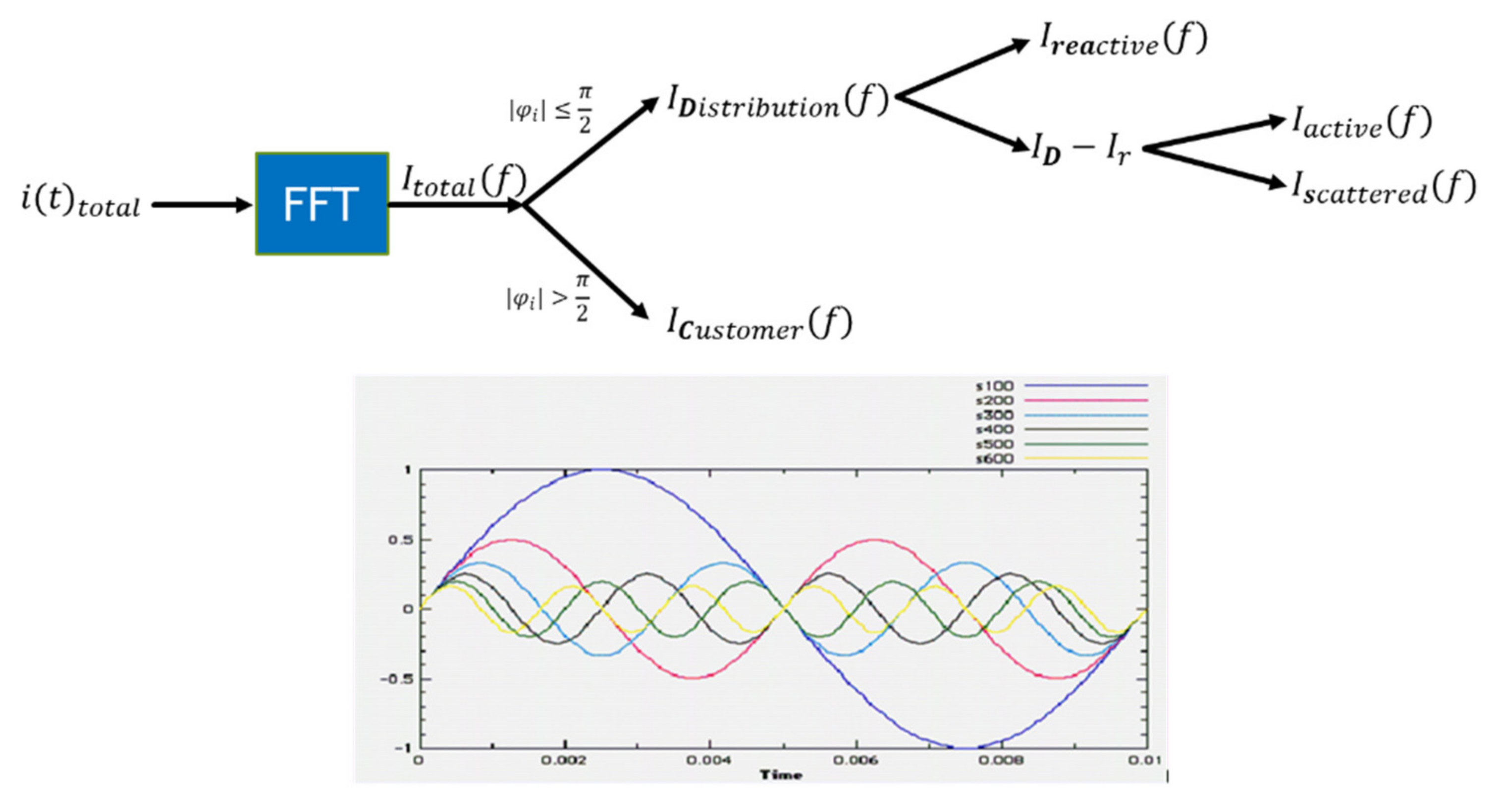


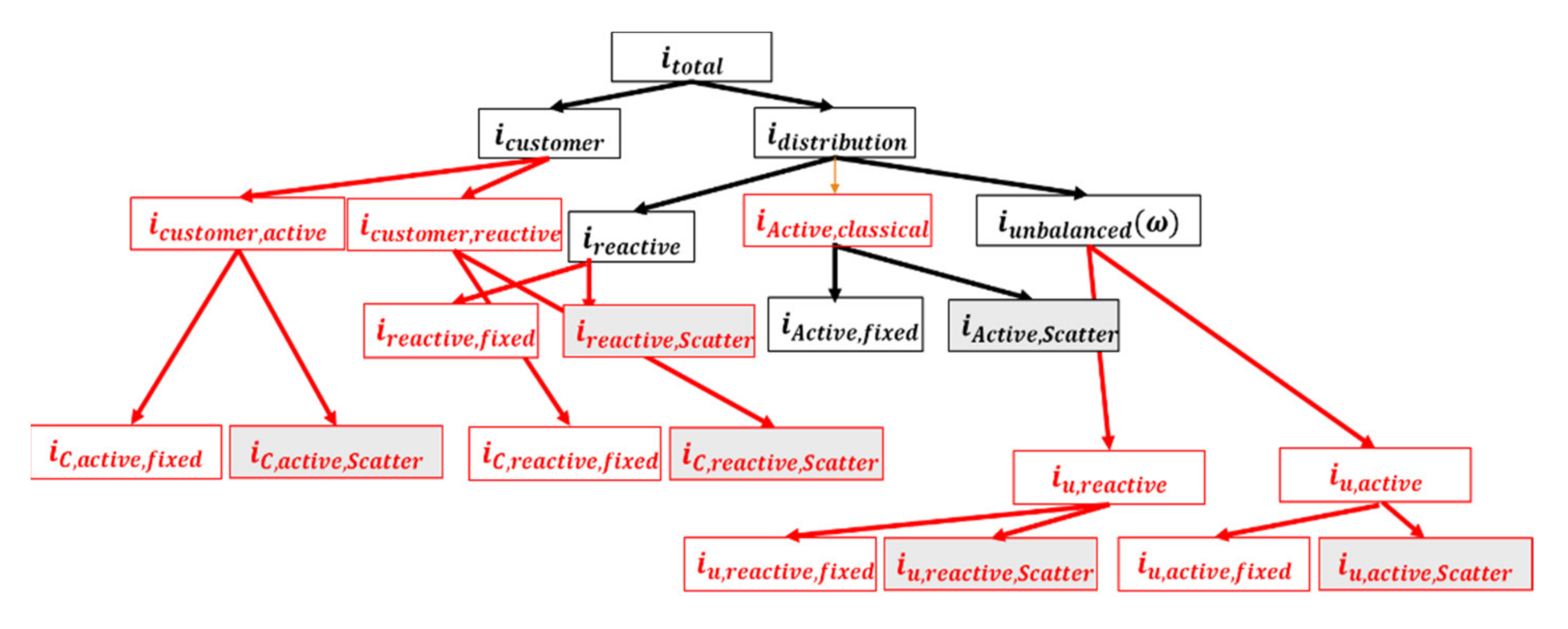


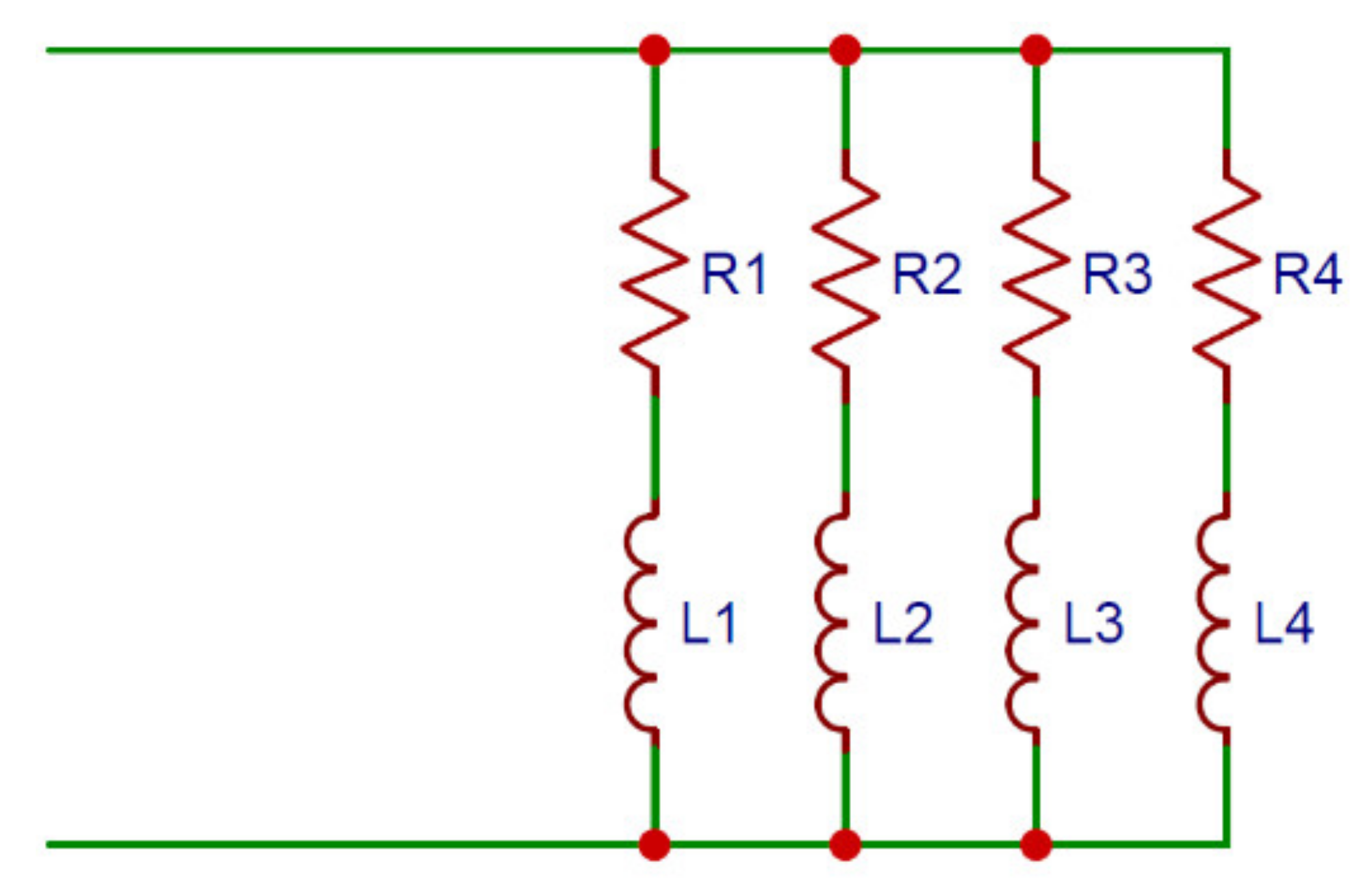




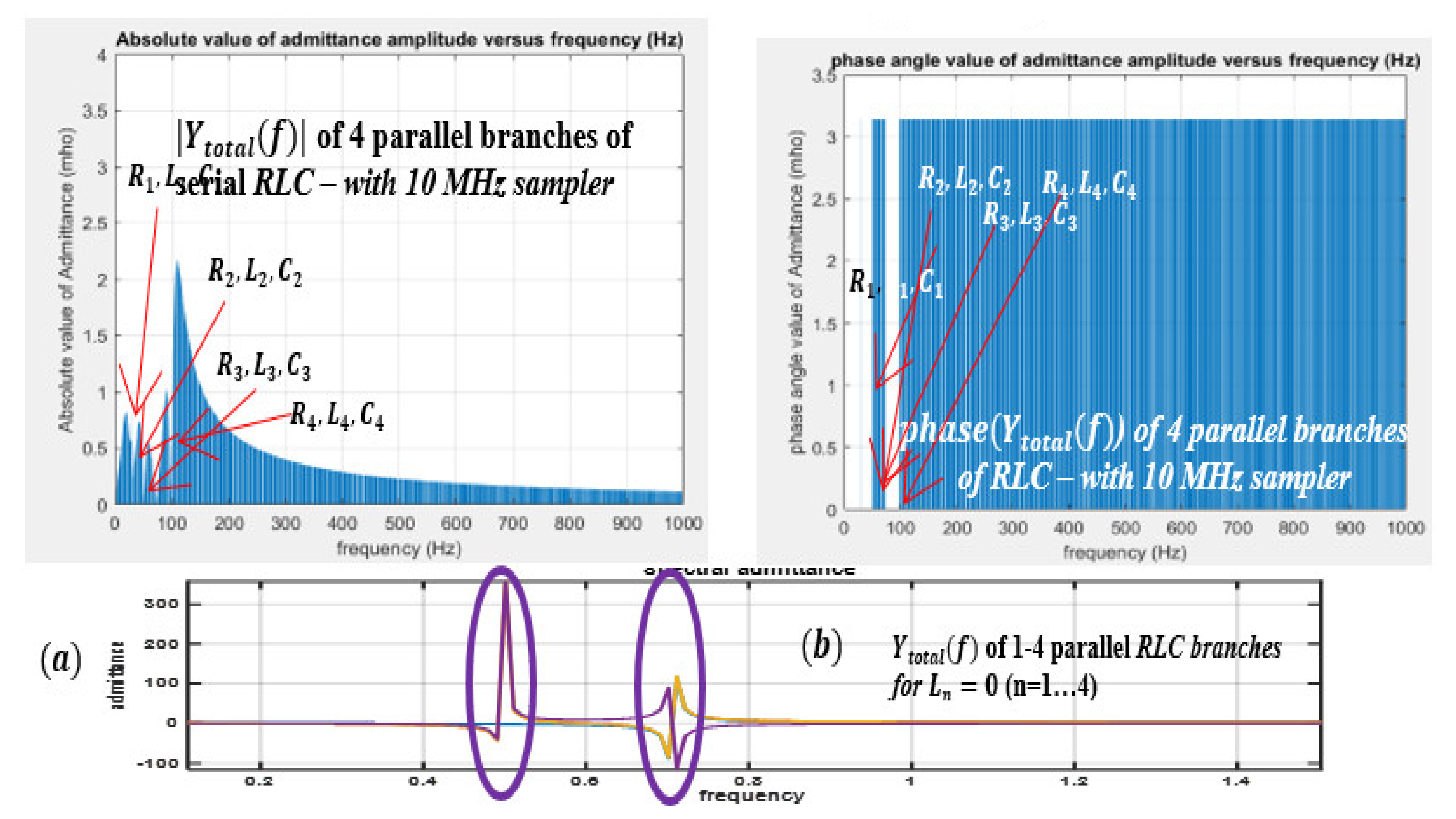


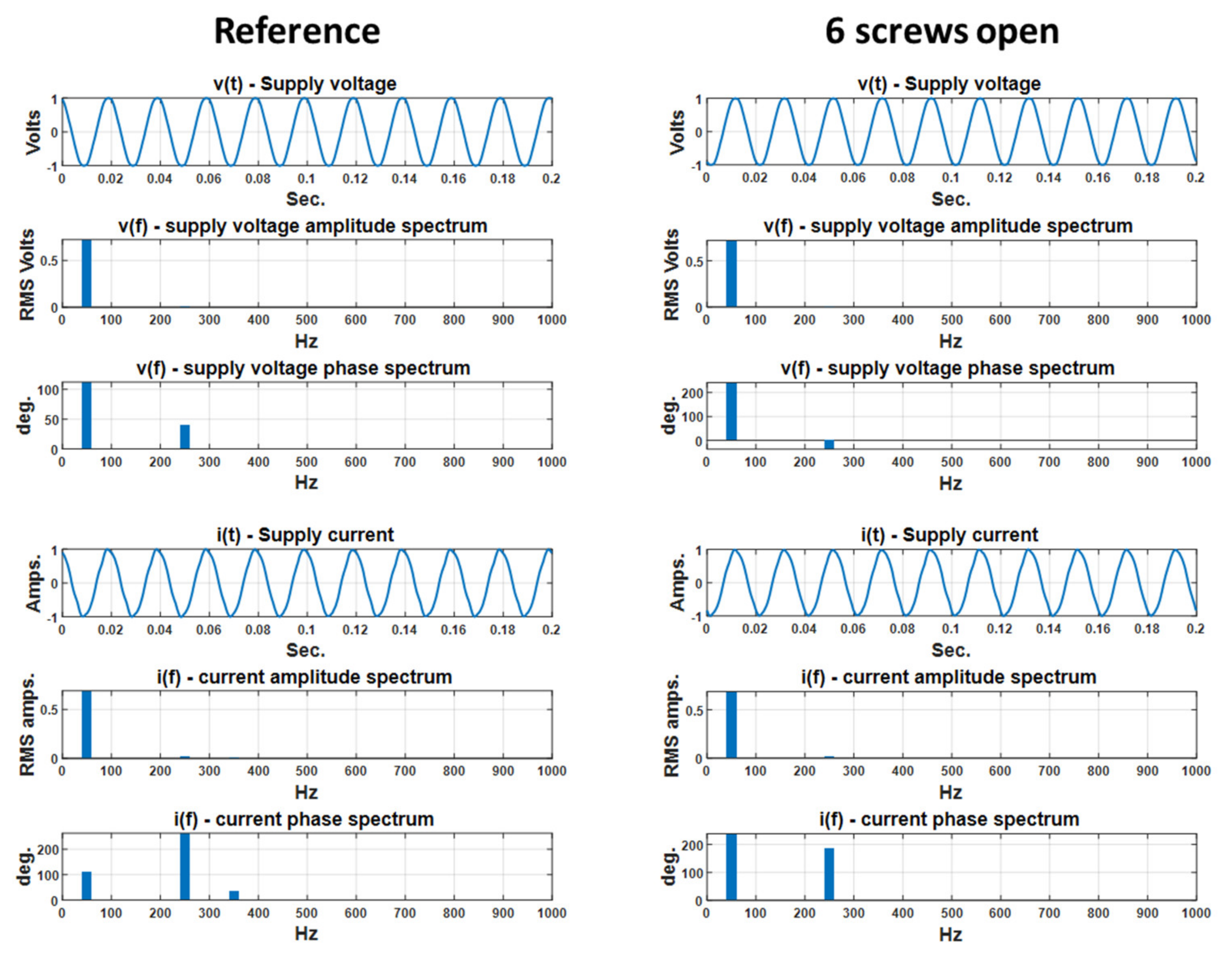

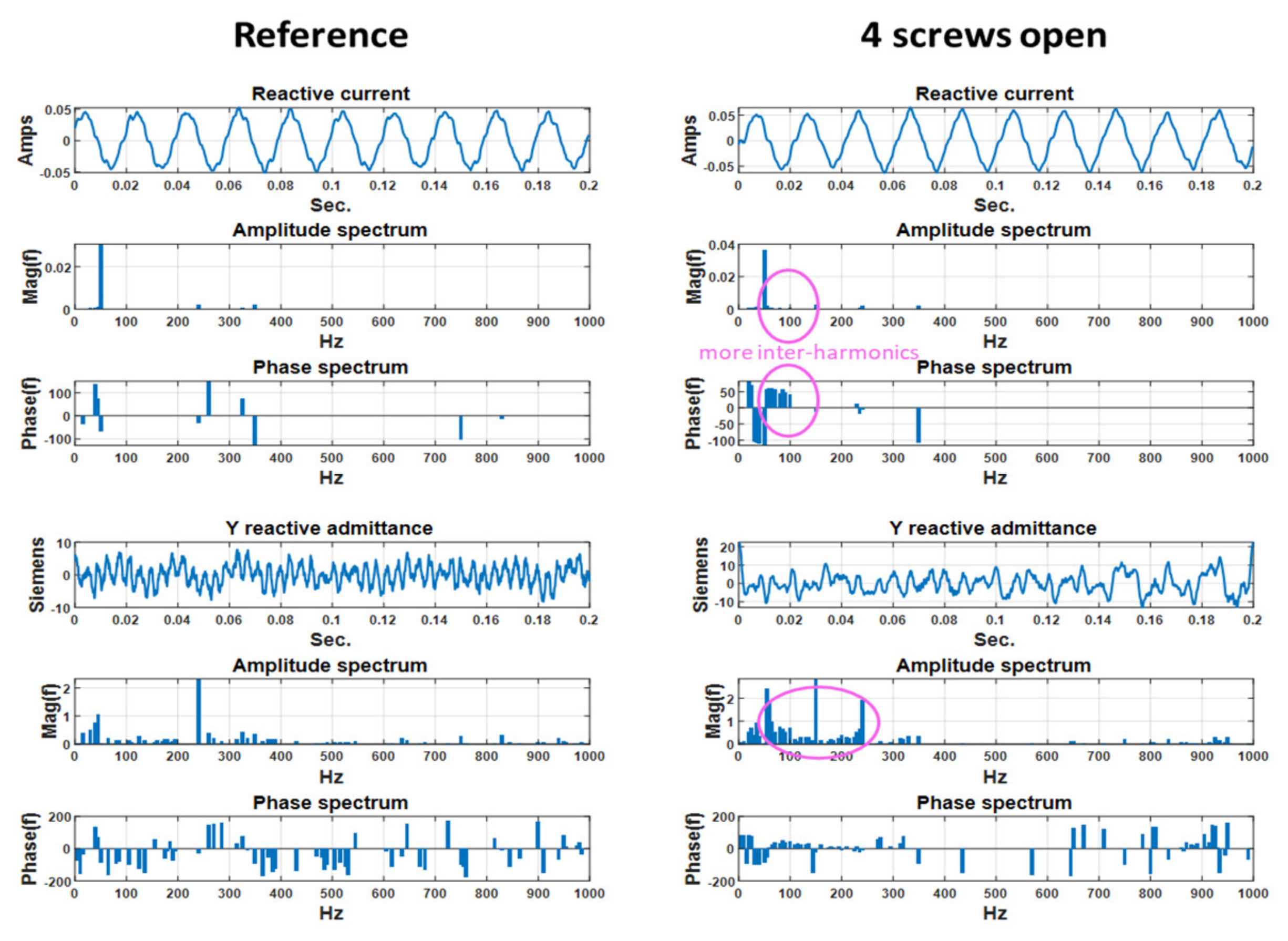
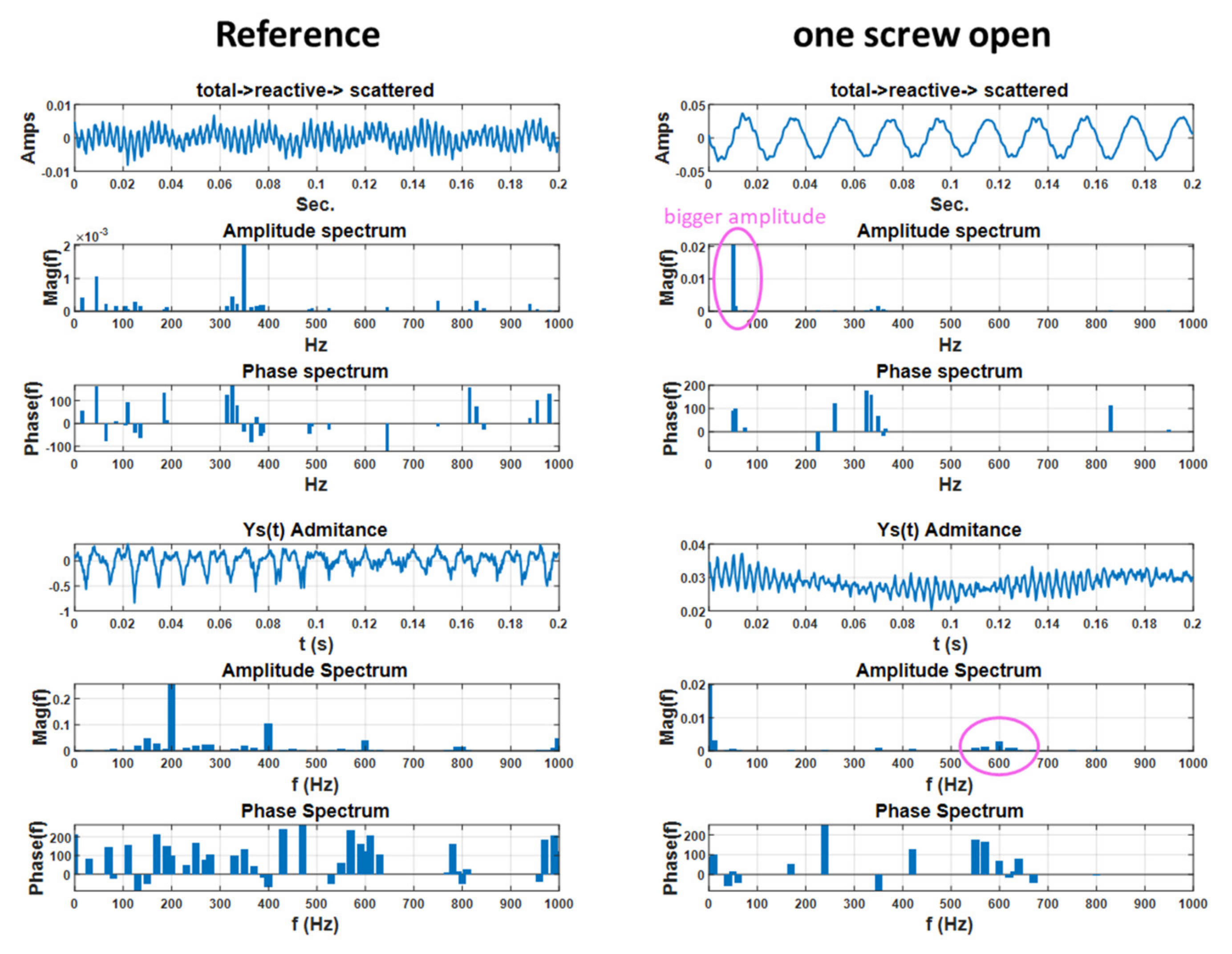
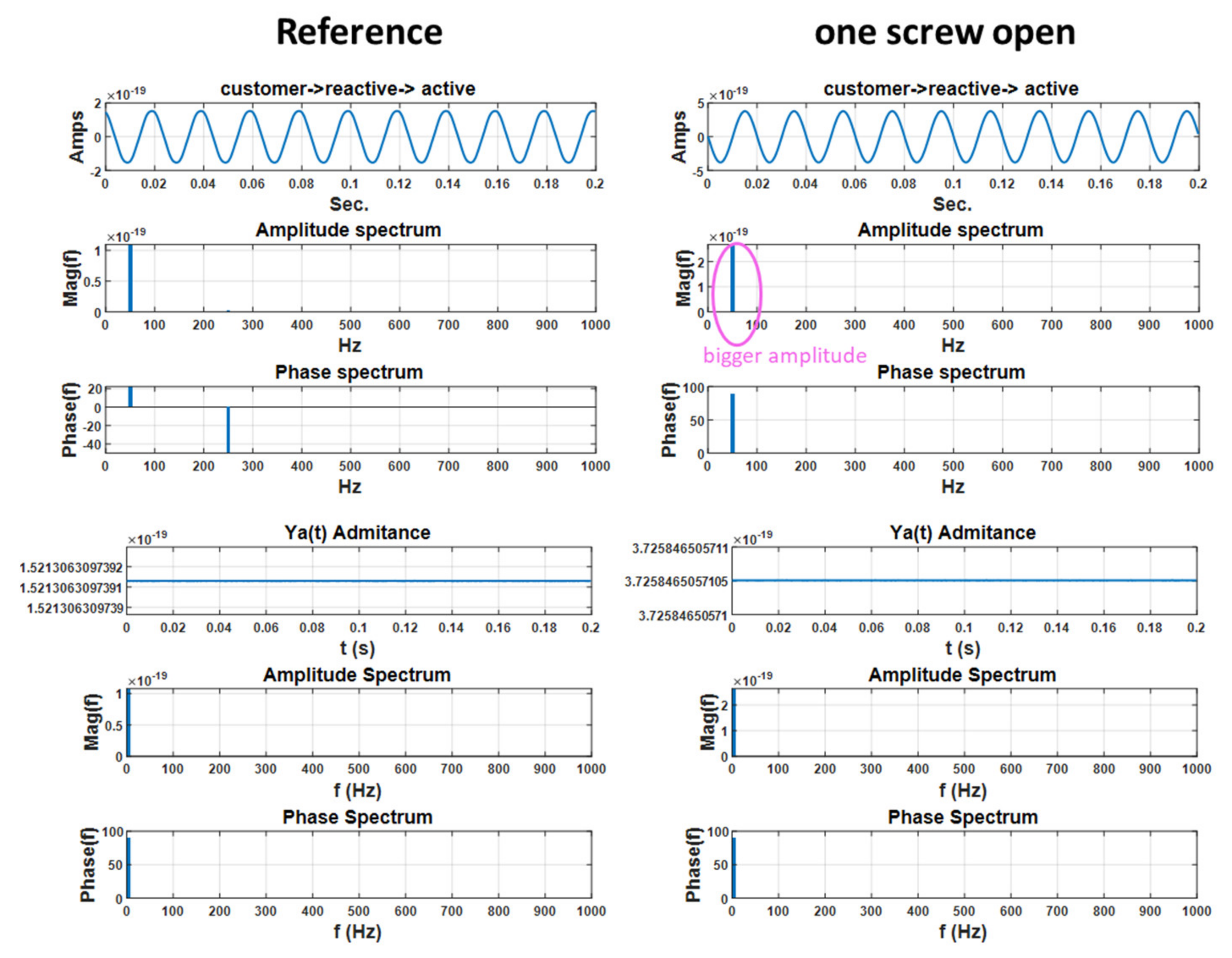
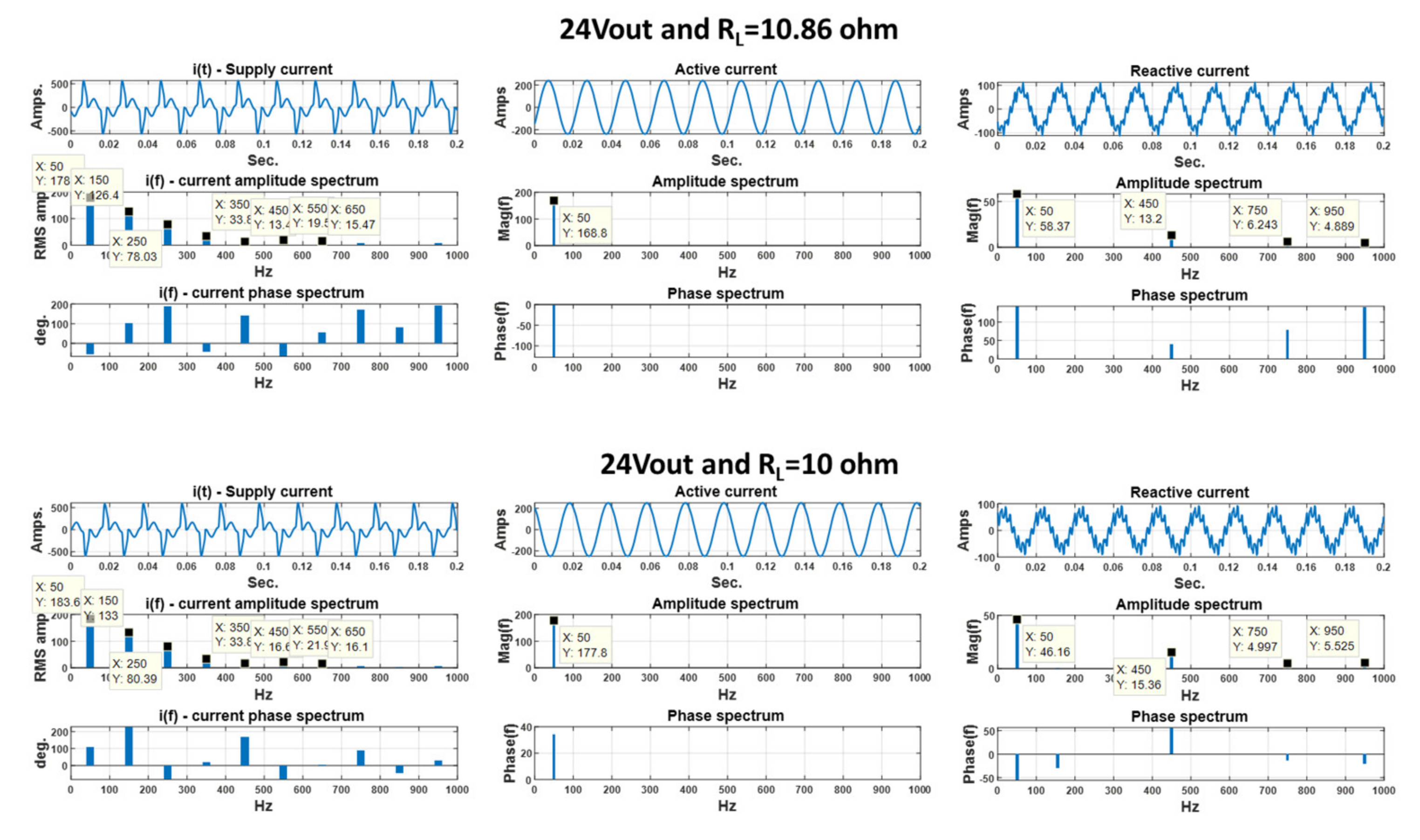
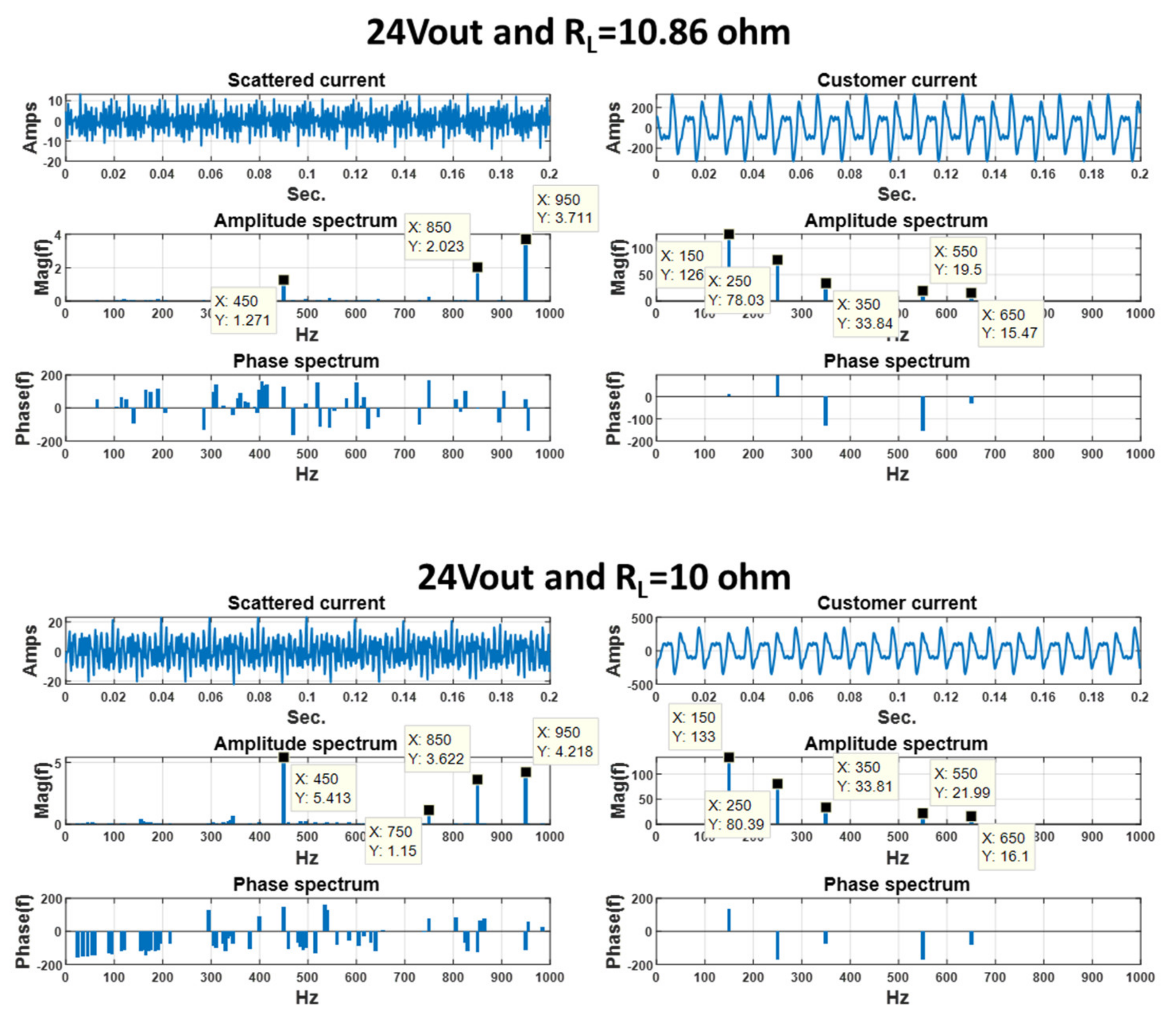
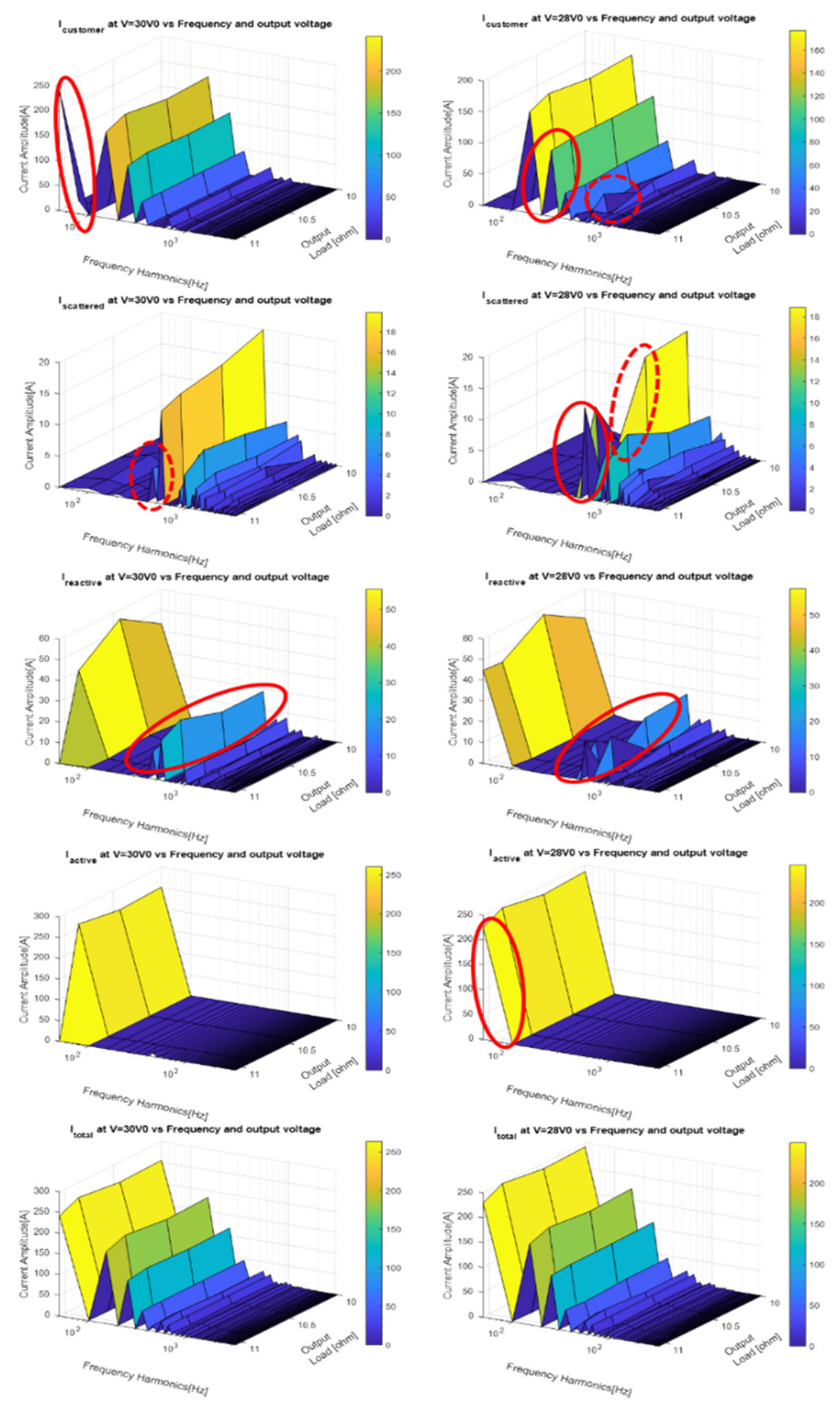
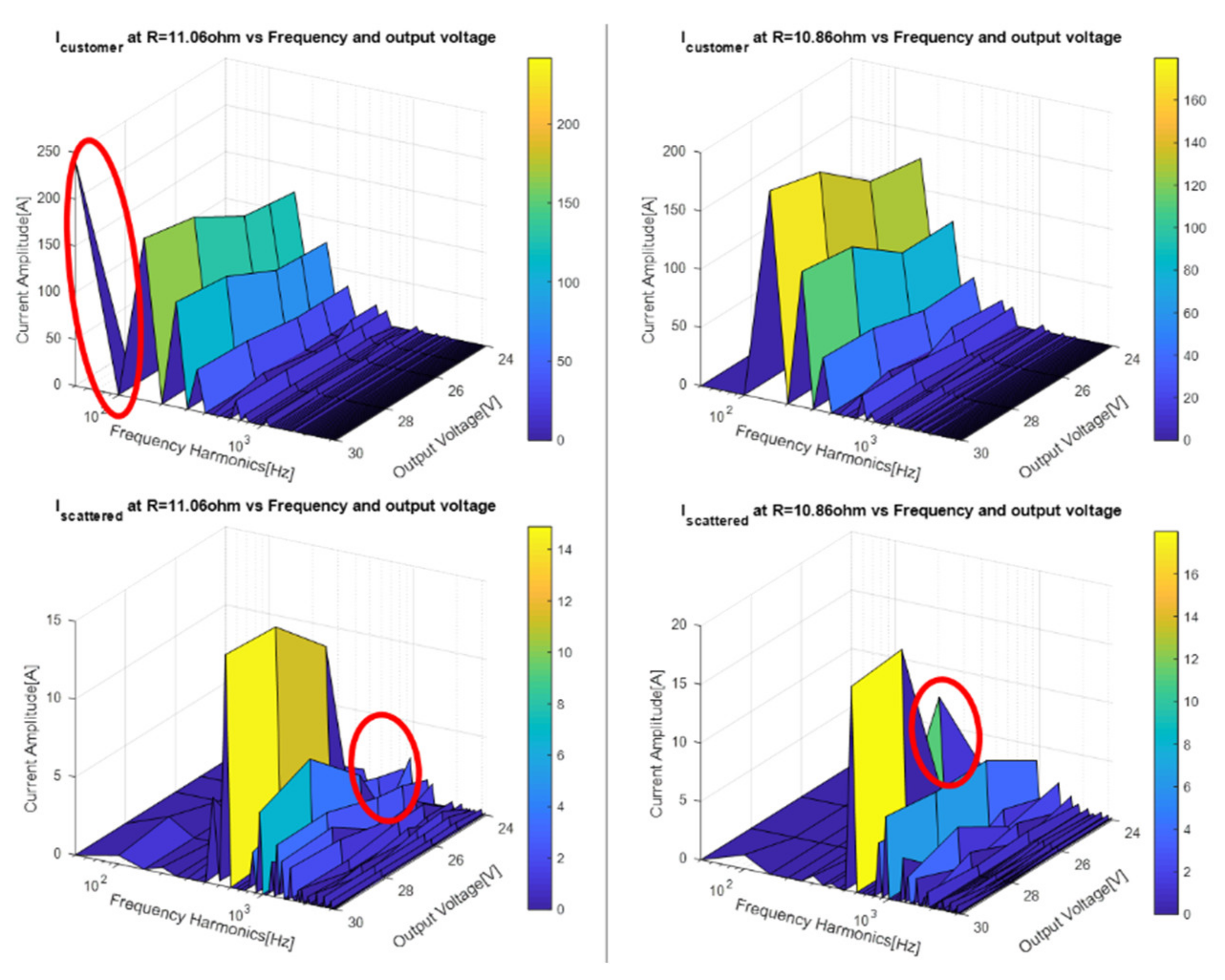
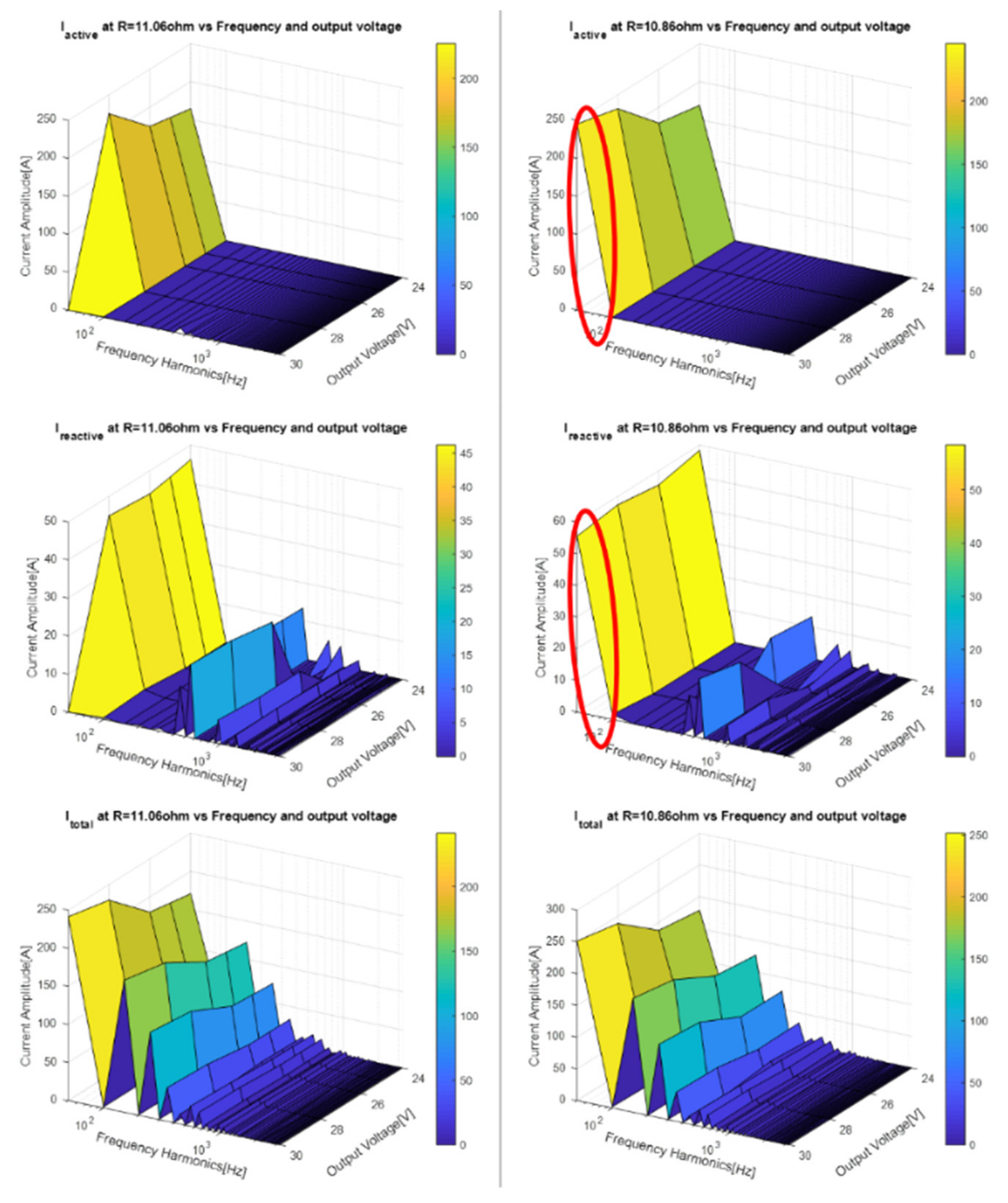


| Case Study | Experiment Description | Relevancy Prioritized |
|---|---|---|
| Loose screws of the motor mount through grid measurement | An AC motor with all screws closed (normal) vs. 6 screws mildly open—a mechanical anomaly phenomenon | Demonstrate that without CPC anomaly is unnoticeable while with CPC it is noticeable. Show a mechanical anomaly is also electrically noticeable |
| Enhanced CPC—by further disassembling the currents | An AC motor with all screws closed (normal) vs. 6 screws mildly open—a mechanical anomaly phenomenon | Demonstrate that E-CPC is even more sensitive to an anomaly than CPC-“- |
| A systematic approach to generating features for AI anomaly detection | An AC/DC inverter as observed from the grid: gradually modify output voltage once, and gradually modify the output load once | Demonstrate a systematic method for noticing a multivariate problem anomaly |
| Connect E-CPC as a preprocessor to a CNN anomaly detector | Measure FFT over raw data vs. E-CPC | Quantitatively evaluate the accuracy and quantity of data required for anomaly detection and show E-CPC supremacy |
| Property. {Training/Testing/Training and Testing} Stage | Raw as Data Input | FFT as Input | E-CPC, CPC as Input |
|---|---|---|---|
| Sensitivity multiplication factor (affect in training/testing stage) | 1 | Theoretical: ~ | Empirical: at least 103 Possibly: 105 (assuming time linear onset of anomaly) |
| Data shrinking multiplication factor into a CNN core Training and testing stages | 1 | Theoretical: 100 | Empirical and theoretical: 100,000 |
| Maximal speed of decision from anomaly onset “multiplication factor” (assuming at least 4000 samples) due to sampling rate (*) Training and testing stages | 1 | Theoretical: 4000 (for 4 kHz sampling) | Theoretical: 4000 (for 4 kHz sampling) |
| Estimated fan-in Training and testing stages | 1 | Theoretical: 50 | Theoretical: At least 50 possibly much more |
Publisher’s Note: MDPI stays neutral with regard to jurisdictional claims in published maps and institutional affiliations. |
© 2021 by the authors. Licensee MDPI, Basel, Switzerland. This article is an open access article distributed under the terms and conditions of the Creative Commons Attribution (CC BY) license (https://creativecommons.org/licenses/by/4.0/).
Share and Cite
Calamaro, N.; Ofir, A.; Shmilovitz, D. Application of Enhanced CPC for Load Identification, Preventive Maintenance and Grid Interpretation. Energies 2021, 14, 3275. https://doi.org/10.3390/en14113275
Calamaro N, Ofir A, Shmilovitz D. Application of Enhanced CPC for Load Identification, Preventive Maintenance and Grid Interpretation. Energies. 2021; 14(11):3275. https://doi.org/10.3390/en14113275
Chicago/Turabian StyleCalamaro, Netzah, Avihai Ofir, and Doron Shmilovitz. 2021. "Application of Enhanced CPC for Load Identification, Preventive Maintenance and Grid Interpretation" Energies 14, no. 11: 3275. https://doi.org/10.3390/en14113275
APA StyleCalamaro, N., Ofir, A., & Shmilovitz, D. (2021). Application of Enhanced CPC for Load Identification, Preventive Maintenance and Grid Interpretation. Energies, 14(11), 3275. https://doi.org/10.3390/en14113275





